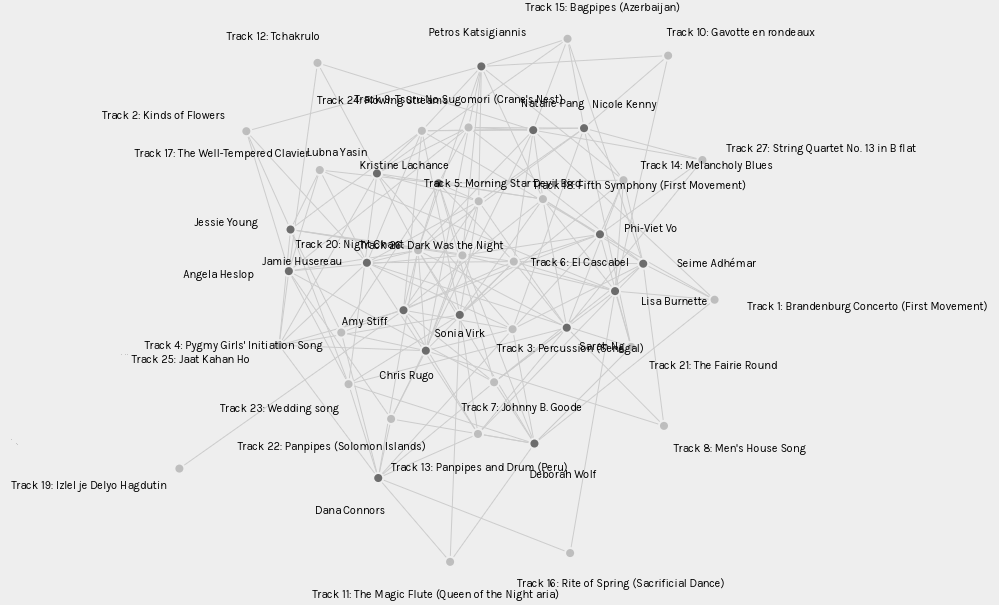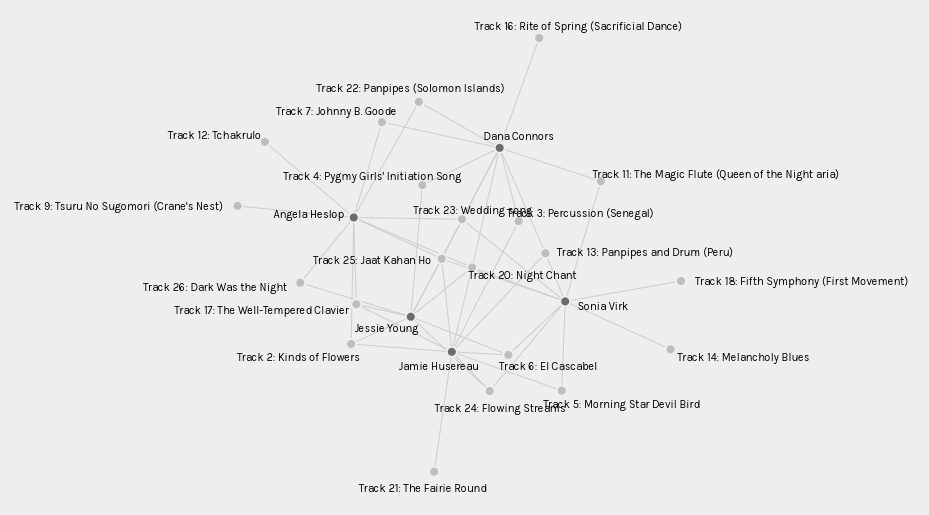The Process
I was quite methodical in my approach to my choices. I started by recording which country and continent each piece of music came from. This was one of my main factors in choosing songs that truly represented the people on planet Earth, as Kurt Waldheim highlighted as the intention of this curation, in the podcast. The purpose was to properly introduce humanity and to collect musical pieces from all around the world so this is what mainly drove my decision-making process. To add, it was stated that one piece represented each “thing” therefore, musical instruments factored into my decision as well; if I had already chosen a song with panpipes or percussion I likely chose a different instrument from the same continent. I still had the two goals at the forefront of my process as well; try to be inclusive as possible and make a good record.
The Music
Australia, Aborigine songs, “Morning Star” and “Devil Bird,” recorded by Sandra LeBrun Holmes. 1:26
This song is one of three from Oceania, which is described as a continent in some regions, this is new to me. At first, I immediately chose this song as it was the only song from the continent of Australia (as I previously knew it) and upon further investigation, I chose to keep it as I appreciated how it is actually two Aborigine songs with one of the most interesting instruments, the didgeridoo. I also liked the dichotomy of bright and dark of the two songs, as well as the representation of the Indigenous peoples of Australia with their voices.
Navajo Indians, Night Chant, recorded by Willard Rhodes. 0:57
This song is one of five possible choices from North America. I chose this one in particular as I think it is important to include Indigenous culture and is in a way one of the closest related to Canadian Indigenous culture. I read that it is a song about healing and restoring culture, a message that I appreciate and admire. This song felt very light with the shaker instruments and the high pitch voices.
Peru, panpipes and drum, collected by Casa de la Cultura, Lima. 0:52
This song is one of two possible choices from South America, based on my list I only chose one song from South America. This is because both songs on the record are from Peru and I thought my narrowing list should not favour two songs from the same country. As I listened and compared the two songs I appreciated the instruments, the panpipes and the drums, over the other song. For some reason, this song reminded me of Peter Pan, and I liked its intensity and mysteriousness with the panpipes and drums.
India, raga, “Jaat Kahan Ho,” sung by Surshri Kesar Bai Kerkar. 3:30
This song is one of eight possible from Asia, depending on how you categorize various countries that may belong to multiple continents, and I only found it fitting to include a song from the most populous place on the planet, as it (in a way) represents the culture of the most amount of people (loosely speaking). I found this song hauntingly beautiful and only fitting for interstellar travel as the title is Where are you going alone, girl?
Holborne, Paueans, Galliards, Almains and Other Short Aeirs, “The Fairie Round,” performed by David Munrow and the Early Music Consort of London. 1:17
This song is one of ten possible from Europe, again depending on categorization. As the UK was historically one of the most influential countries in the world, especially to Canada (ie. British monarch), I thought it fitting to include it. I also think the use of the recorder is too good to pass up, as the recorder was a staple of my middle school music experience. It is a very light and airy song, it made me feel joy and happiness as I listened to it. I could picture dances and courtship as I listened to the high notes and bright melody.
Mexico, “El Cascabel,” performed by Lorenzo Barcelata and the Mariachi México. 3:14
This song is the second chosen of five possible choices from North America. I had already chosen a song from the USA, so I wanted to diversify and bring in the fun and exciting sounds of Latino music. I read that music in Spanish may be the second most consumed music in the world which is a noteworthy statistic. The fast rhythm and mariachi band beats made me want to dance, it sounded like something very exciting was happening throughout this song of The Little Bell.
China, ch’in, “Flowing Streams,” performed by Kuan P’ing-hu. 7:37
This song is the second chosen of eight possible from Asia. Similarly to the song from India, I chose a song from China as not only is it the second most populous country in the world but is also (sometimes frighteningly) influential and powerful on an international scale. Although, I do love the sentiment of ever-moving water and the intriguing introduction of plucking strings drew me further into the song. There were ebbs and flows of the harder and lighter plucking of the strings, just as a river would act.
Bach, The Well-Tempered Clavier, Book 2, Prelude and Fugue in C, No.1. Glenn Gould, piano. 4:48
This song is the second chosen of ten possible from Europe. It only made sense to me to choose at least one song from Bach as there were three on the record. I debated between Bach and Beethoven, as people would argue Beethoven is better, however, statistically speaking this choice sat better. I also found it interesting the conversations that revolved around the mathematical concepts of these pieces included from Bach and Beethoven. This particular Bach song was chosen because the instrument was the piano, something that the other songs did not include.
Java, court gamelan, “Kinds of Flowers,” recorded by Robert Brown. 4:43
This song is the second chosen of three from Oceania. I enjoyed the various percussive instruments and I read that it is a traditional ensemble of various peoples of Indonesia, and therefore a more diverse representation of people. There was a lot going on right from the beginning of this piece and the interesting addition of the various voices overlapping was intriguing and beautiful, it made me sway back and forth with the carried notes.
Senegal, percussion, recorded by Charles Duvelle. 2:08
This song is the only song from Africa on the list, and therefore should absolutely be on the record. The other record that may be included for Africa is Pygmy Girls, however, from what I could find, it was a British American who recorded it so I shied away from this choice. The drums at the very beginning made me want to shake my hips, I pictured people in regalia and traditional dances when I closed my eyes and listened.
A burning need to share my runner-ups;
“Johnny B. Goode,” written and performed by Chuck Berry. 2:38
I read this piece was a little controversial as rock music was deemed adolescent to which the reply was there are many adolescents on the planet. Love it!
Beethoven, Fifth Symphony, First Movement, the Philharmonia Orchestra, Otto Klemperer, conductor. 7:20
Classic. Classic. Classic. Duh duh duh duuuuum.
References
Taylor, D. (Host). (2019, April). Voyager golden record. [Audio podcast episode]. In Twenty thousand hertz. Defacto Sound.






